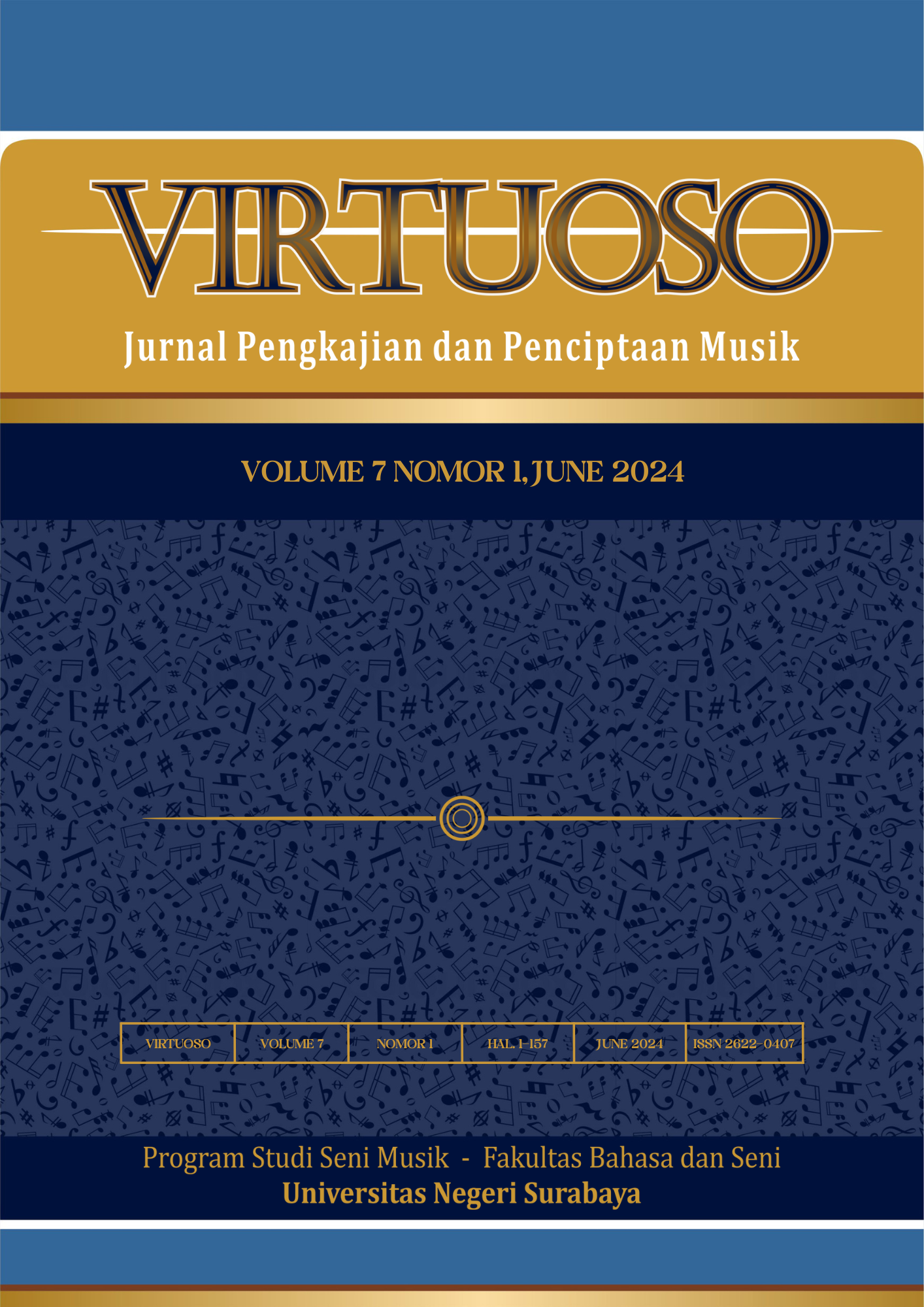PAPATEAN: Representational Musical Composition of the Story of the Murder of Missionary A. A. van De Loodstrecht in Bori', Toraja
Main Article Content
Abstract
The musical composition "Papatean" is based on the story of the murder of the first missionary in Toraja, namely A. A. van de Loodstrech (called Anton) in 1917. Studying history is certainly important because it is full of values??for a better future. After Anton's death, the growth of the congregation in the Toraja Church continued to improve, until it spread internationally. Apart from that, the creation of this musical work aims to remember and appreciate the struggle and dedication of Anton and his wife, who have given their entire lives to God and the Toraja people. Their arrival brought the Gospel as well as the beginning of education in Toraja. The theory used in producing this work is about musical composition, musical harmony, instruments, and program music including narratives, vocals, and scales. The musical instruments used are the Lembang Flute, Piano, Violin, Viola, Violoncello, Contrabass, Floor, Cymbals, Chimes, and Vocals. The method used is the creation method, with several stages, namely (1) Data collection stage (2) Idea stage (3) Exploration stage (4) Implementation stage (5) Formation stage. The work "Papatean" was worked on in three parts, namely part I: Petamba (A, B), part II: Sitiro Lindo (A, B), and part III: Papatean (A, B, C, D).
Downloads
Article Details

This work is licensed under a Creative Commons Attribution-NonCommercial-ShareAlike 4.0 International License.
The copyright of the received article once accepted for publication shall be assigned to the journal as the publisher of the journal. The intended copyright includes the right to publish the article in various forms (including reprints). The journal maintains the publishing rights to the published articles.
References
Barrie, N. (1987). Harmoni 1 (B. C. O. Music (ed.)). Brklee College Of Music.
Hood, M. (2020). Musics of Many Cultures. In Musics of Many Cultures. https://doi.org/10.1525/9780520340572
Kantarelis, S., Dervakos, E., Kotsani, N., & Stamou, G. (2023). Functional harmony ontology: Musical harmony analysis with Description Logics. Journal of Web Semantics, 75, 100754. https://doi.org/10.1016/j.websem.2022.100754
Leon Stei. (2008). Structure and Style: The Study and Analysis of Musical Form. Summy-Bichard Music.
Lestari, D. T. (2019). Musik, Konflik, dan Perdamaian: Studi Etnomusikologi. PT Kanisius.
Mihela?, L., & Povh, J. (2020). The impact of the complexity of harmony on the acceptability of music. ACM Transactions on Applied Perception, 17(1). https://doi.org/10.1145/3375014
Naiko, N. M. (2022). Elements of Programme Music in the Instrumental Works of the Late Period by Oleg Meremkulov (the Case of the Symphony Concerto for Cello, Piano and Orchestra). Journal of Siberian Federal University - Humanities and Social Sciences, 15(1). https://doi.org/10.17516/1997-1370-0877
Nicolay Sfetcu. (2014). The Music Sound. Dorling Kindersley.
Plaisier, B. (2016). Menjembatani Jurang, Menembus Batas; Komunikasi Injil di Wilayah Toraja 1913-1942. BPK Gunung Mulia.
Soler, S. O. (2020). The Music of Oral Tradition in the Times of World Music. Is Legal Protection Possible beyond Copyright? Oido Pensante, 8(1). https://doi.org/10.34096/OIDOPENSANTE.V8N1.7598
Sunarto, B. (2020). Epistemologi Penciptaan Seni. ISI PRESS.
Tapilatu, M. dkk. (2005). Dari Benih Terkecil, Tumbuh Menjadi Pohon; Kisah Anton dan Alida van de Loosdrech, Misionaris Pertama ke Toraja. Badan Pekerja Sinode Gereja Toraja.
Th. van den End & J. Weitjens, S. (1993). RAGI CARITA: Sejarah Gereja Di Indonesia 1860an-Sekarang. BPK Gunung Mulia.
Thomas, M. (2023). Form as Harmony in Rock Music. Journal of Music Theory, 67(1). https://doi.org/10.1215/00222909-10232129
Toraja, B. P. S. G. (2017). Tata Gereja Toraja (Edisi 1). Badan Pekerja Sinode Gereja Toraja.
Tumaang, Y. (2022). Perjumpaan Antara Injil dan Kebudayaan Dalam Konteks Budaya Toraja Melalui Model Terjamahan Kontekstual. OSF Preprints, 3.
Zhu, M. (2023). Research on Chord Generation in Automated Music Composition Using Deep Learning Algorithms. Informatica (Slovenia), 47(8). https://doi.org/10.31449/inf.v47i8.4885

